
The June solstice is just around the corner, and my garden is ready:
Sunflowers and corn have each been transplanted out of the cold frame and into their respective beds.
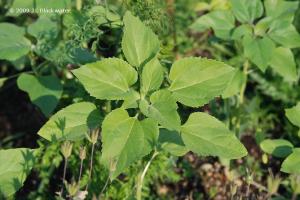
The heliotropes (flowers which turn with the sun, including sunflowers) stand healthy on three-foot-tall stems lining a new flowerbed located along the northern fence line of my yard. These sunflowers are the progency of my Pennsylvania garden including both the giant and the shorter, red sunflowers.
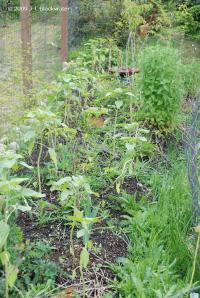
What was once a barren stretch of grass is now home to flowers selected from all around my yard including daisies, dianthus, bee balm, columbine, carrots, daffodils, and many others. I’ve packed a lot of plants into this small space, which is also the new home to 10 trees (originally received from The Arbor Day Foundation some eight years ago) including dogwoods, hawthorns, and crab apples.
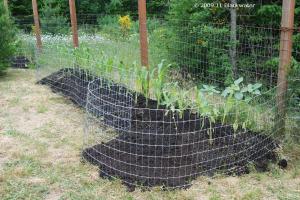
The corn (which, if you didn’t know, is a really big grass) now lines the western fence line in two long beds of approximately 40 plants each.
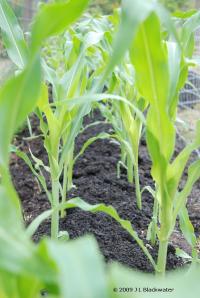
Once the corn was put in place, the beds were sown with beans, pumpkins, zucchini, and melons, with a few sunflowers and nasturtium seeds to artfully anchor the ends of each. I am pleased to say that the corn is well ahead of the requisite “knee-high by the Fourth of July” benchmark. This is my first real attempt at growing corn; after three years of living around Pennsylvania farmland for inspiration, I am eager to see my results! Beyond the fenced yard is a healthy wildflower patch containing foxglove, fireweed, daisies, and brambles, which I have carefully encouraged for some 10 years. I hope that these flowers will help to attract the wild pollinators that I need for the vegetables.
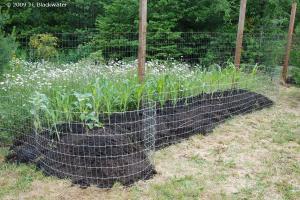
Why are the growing beds all fenced in, you may ask?

Tomatoes, peppers, basil, and marigolds which once in habited all free window spaces inside the house are now safely settled in the vegetable garden. Although the tomatoes were looking a little scraggly indoors, they positively exploded outside. I’m sure that flowers are only a week or two away. The basil hardly seems to have noticed the move, and the peppers are slowly catching up thanks to the warm weather we’ve enjoyed.

Meanwhile, back in the cold frames the arugula, lettuce, assorted salad greens, and cilantro have all made a great showing, and are ready to bolt like nobody’s business.
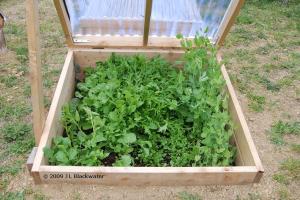
I plan to dig them out in chunks and pop them in the flower beds so they can flower and seed to their hearts’ content. Personally, I think arugula, radish, and cilantro flowers are lovely. So too for the furry purple flowers of the chives plants which welcome me to the vegetable patch each morning.

The peas also need to come out of the coldframe and into the garden – they’ve grown big enough to create a trellis out of each other for support!

And of course, summer wouldn’t be complete without the sweet, ripe strawberries swelling like so many rubies in the vegetable garden:
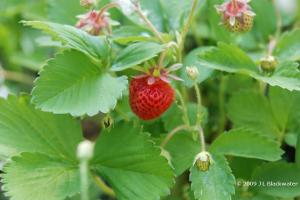
What’s next? Believe it or not: autumn. The efforts needed for summer vegetables were all completed in winter and spring. Now that those tasks are behind me, there’s little else to do but water and weed and watch and harvest. What’s important now is to plan, prepare, and plant for the coming cool seasons.
For me this means moving things out of the cold frames so I can begin successions of lettuce, greens, onions, carrots, and other small veggies. I want to get these started now and continue sowing seeds at roughly two-week intervals from now through October. These will provide the food supply for autumn, and ensure that I have plants at several stages of maturity (rather than one, big, massive patch of lettuce that’s ready all at once).
In addition to the food plantings I am also focused on developing the flowers which grow throughout the gardens. I have healthy seedlings of calendula, borage, and marigolds, and recently added mature bergamot (also called bee balm or monarda), lavender, and rosemary to compliment my existing collections of mints, thyme, parsley, chamomile, and other flowers and kitchen herbs. Thanks to my mother and eldest sister I was able to stock up on seeds via Seeds of Change, so my personal seed bank includes hollyhocks, dahlias, bergamots, sages, and many others.
Ahead at AppleJade I’ll be sharing ideas for creative ways to reuse packaging for seed starting, earth-friendly ways to reduce your slug and pest populations, and plenty of ideas for recipes to make use of your garden bounty!

Filed under: Garden, Goals, Health | Tagged: AppleJade, arugula, autumn planting, basil, beans, bee balm, bergamot, bolting, borage, brambles, calendula, carrots, chamomile, chives, cilantro, cold frame, coldframe, columbine, corn, crab apples, cucurbit, daffodils, dahlias, daisies, dianthus, dogwoods, fireweed, flowerbed, flowers, foxglove, Garden, grass, harvest, hawthorns, heliotrope, hollyhocks, kitchen herbs, knee-high by the Fourth of July, lavender, lettuce, marigolds, melons, mints, monarda, nasturtiums, onions, parsley, peas, peppers, planning, planting, plants, pollinators, pumpkins, radishes, rosemary, sages, salad greens, seed bank, seeds, Seeds of Change, solstice, spring, squash, strawberries, summer, sun, sunflowers, thyme, tomatoes, transplanting, trees, trellis, vegetables, veggies, watch, water, weed, wildflowers, zucchini | Leave a comment »


 Follow Jade Blackwater on Twitter
Follow Jade Blackwater on Twitter
